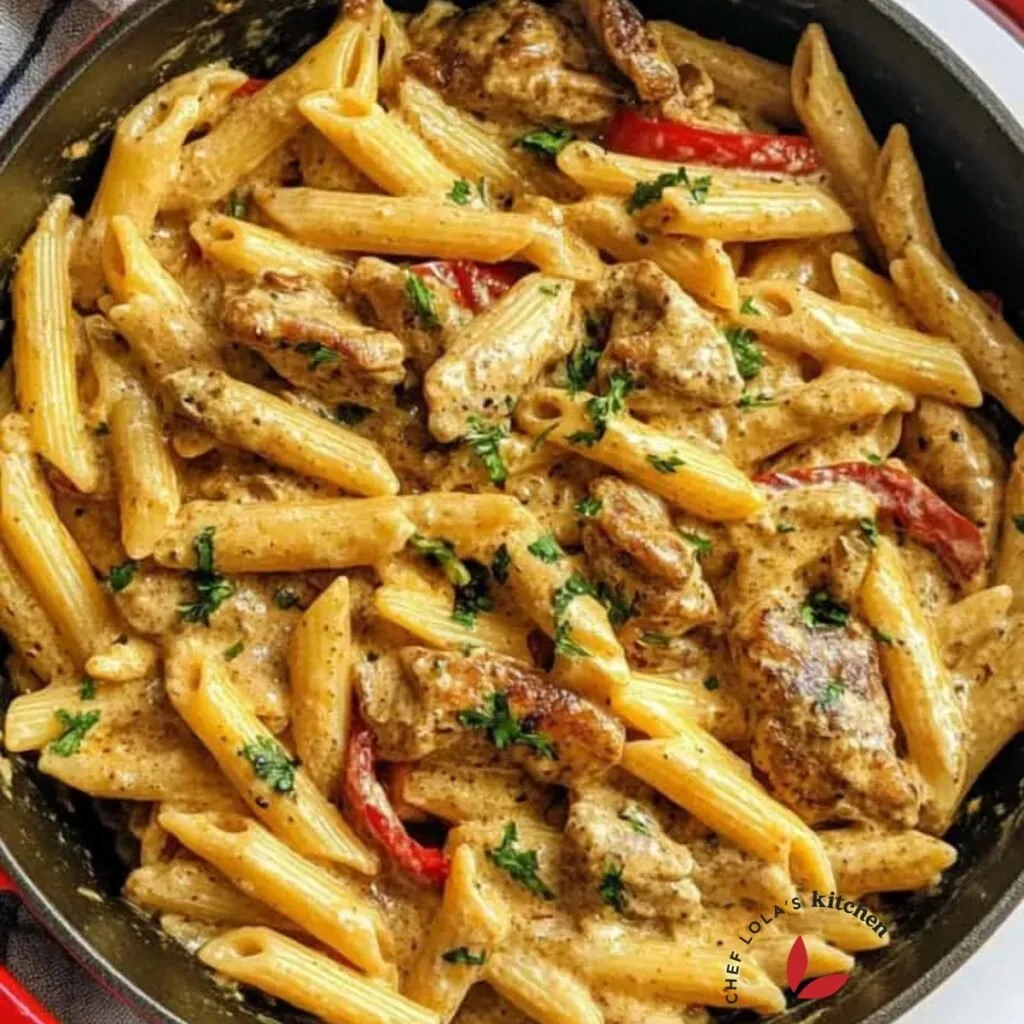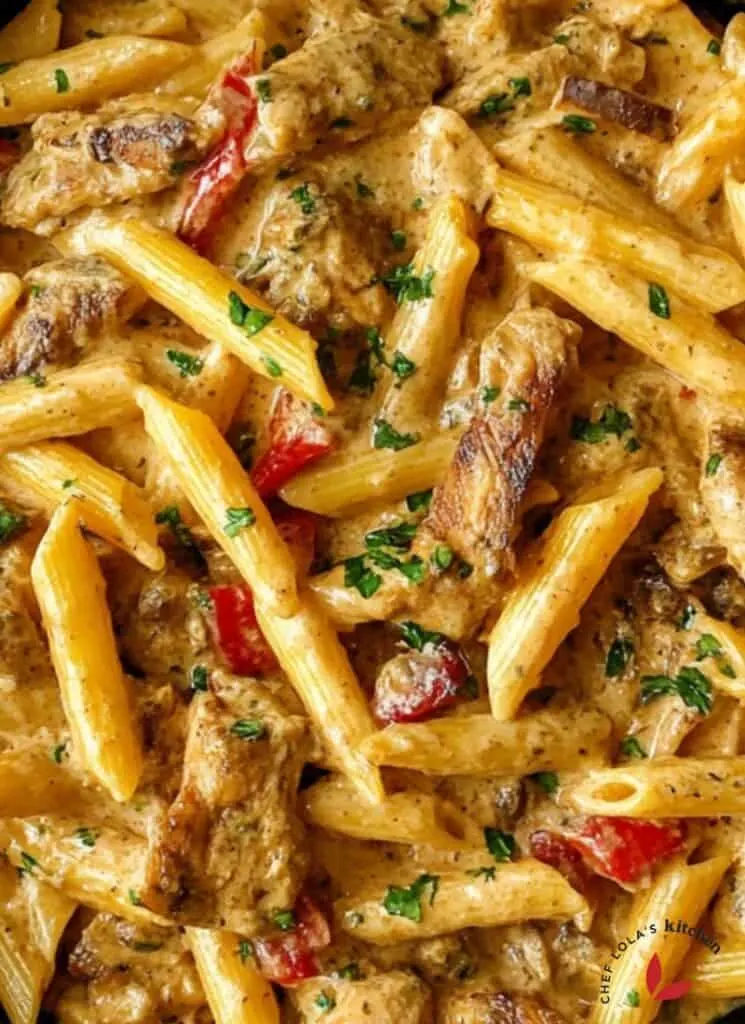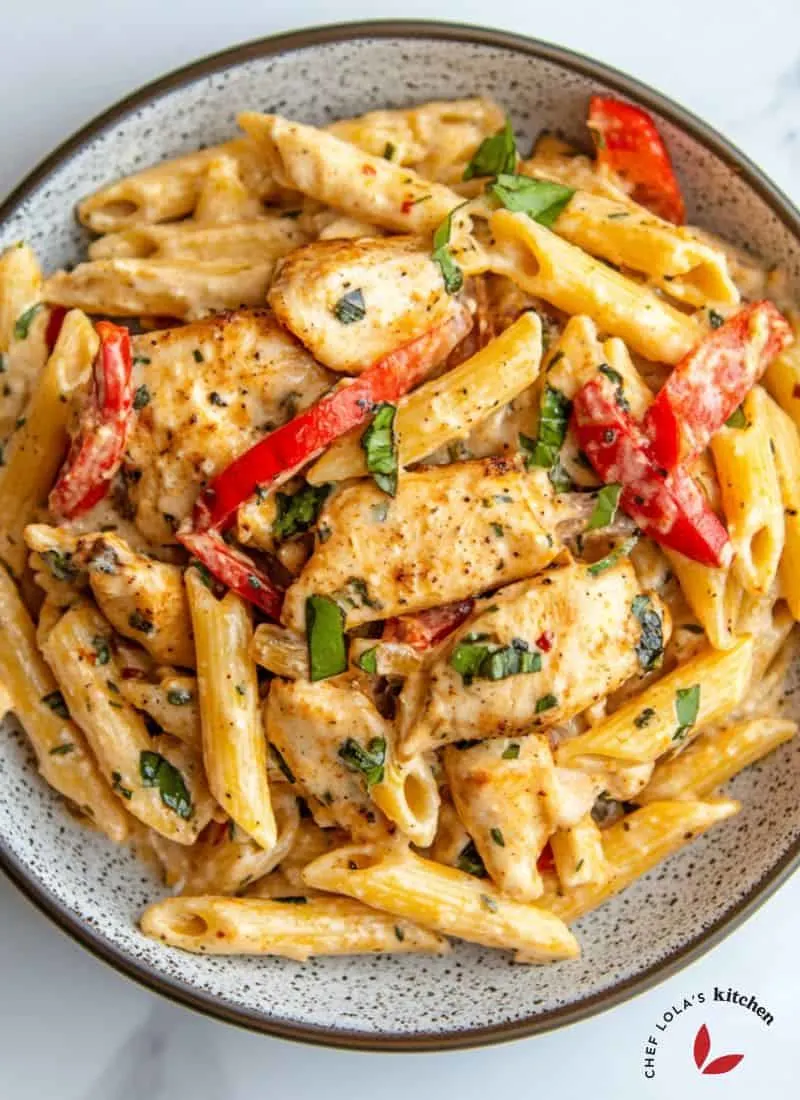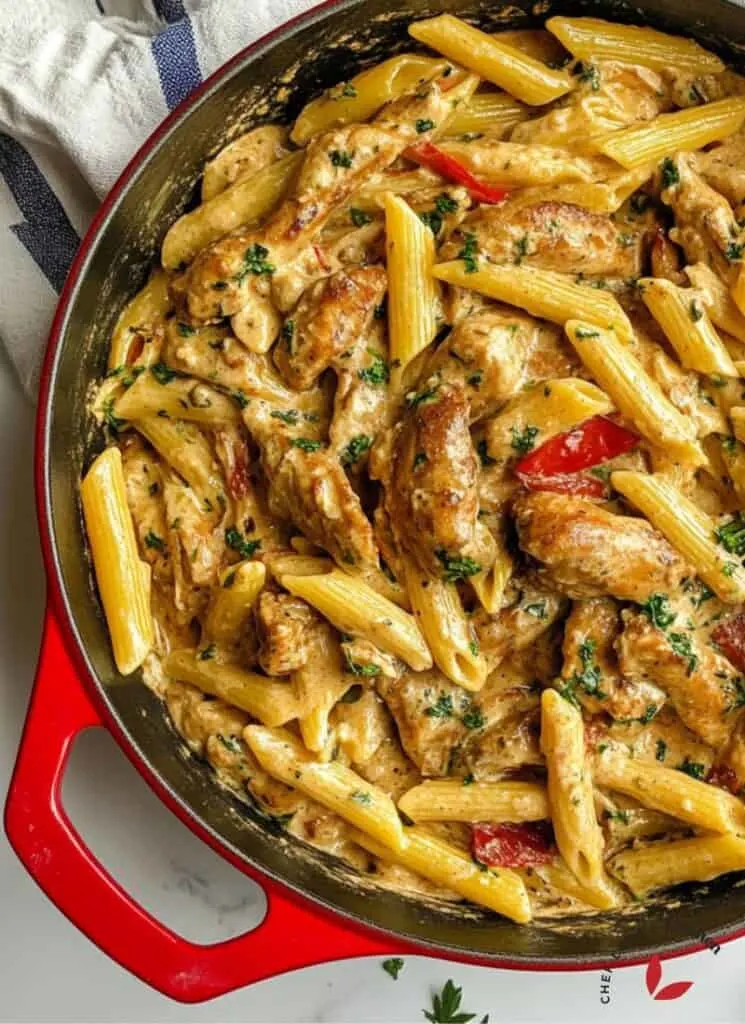Rasta Pasta is a delicious and flavor-packed meal, perfect for a weeknight dinner. It is a rich, cheesy, and all-round great meal to savor with family and friends. You'll need less than 1 hour to prepare this!

If you're a fan of bold and flavorful dishes, then you'll love Jamaican Rasta Pasta. This creamy, flavorful dish is a staple in Jamaican cuisine and is loved by many. But what exactly is Rasta Pasta, and how can you make it at home?
What is Rasta Pasta?
Rasta Pasta is a fusion of Jamaican and Italian cuisine, combining jerk chicken or shrimp with creamy pasta. It is a colorful meal of pasta, bell peppers, onions, and a creamy sauce made from heavy cream and spices. The name "Rasta" is from the Jamaican culture, and it is because of the similar Rasta colors the meal has.
Jamaican cuisine is known for its bold and vibrant flavors, influenced by the island's rich history and diverse cultural influences, from jerk chicken to Jamaican Callaloo and curried goat. Jamaican food has a lot to offer.
Type of Pasta to use
When making Jerk Chicken Jamaican Rasta Pasta, it's best to use Penne, fettuccine, rigatoni, fusilli, farfalle, macaroni, and other types of short pasta work perfectly for this recipe. They are the best for absorbing the hearty and creamy sauce.

Jerk seasoning
Jerk seasoning is a blend of spices that is commonly used in Jamaican cuisine. It typically includes ingredients such as allspice, thyme, garlic, and scotch bonnet peppers. You can find jerk seasoning at most grocery stores, but if you can't find it, you can make your own.
Marinating your chicken in the jerk seasoning makes it super flavorful. While you can get the jerk seasoning from the grocery store, making your own is the best. It is easy to make, and the quality will be better than the store-bought version. Add in the jerk seasoning according to the heat level you prefer. It is also important to note that the heavy cream (or milk) used can water down the heat from the seasoning.
Ingredients you will need for this creamy rasta pasta
- Pasta: The main ingredient in rasta pasta, typically made with penne or another type of pasta, provides the base for the dish.
- Olive oil: Used for cooking the chicken or shrimp and sautéing the onions and garlic. Olive oil adds flavor and helps prevent sticking.
- Boneless chicken: Protein options for the dish, chicken are usually seasoned and cooked separately before being added to the pasta.
- Jamaican Jerk Seasoning: This gives the meal depth and adds tons of flavor to the meal. You can buy in store but I suggest you make yours as it is quite easy to make.
- Onion: Adds sweetness and depth of flavor to the dish when sautéed with garlic, contributing to the overall taste.
- Garlic: A key ingredient in rasta pasta, garlic provides a rich, aromatic flavor and enhances the savory profile of the dish.
- 2 bell peppers each (you can choose red, yellow, or green): Slice them thinly. They add a pop of color and flavor to the meal.
- Coconut milk: Use this to create a creamy and luxurious sauce for the pasta. It adds richness and helps bind the flavors together.
- Grated Parmesan cheese: Adds a nutty and salty flavor to the pasta, while also providing a creamy texture when melted into the sauce.
- Salt: to taste
- Freshly ground black pepper: This is to add mild heat and enhance the overall flavor profile of the dish.

How to make Rasta Pasta
- Cook pasta until al dente, then drain.
- Heat 2 tablespoons of olive oil in a skillet.
- Season and cook chicken until it is no longer pink. Set aside.
- In the same skillet, cook onion, garlic, and bell peppers until tender.
- Add chicken back to the skillet, along with cream, Parmesan cheese, salt, and black pepper. Simmer until thickened.
- Add cooked pasta to the sauce and toss to coat.
- Cook for 2-3 minutes until heated through.
- Serve warm, garnished with fresh thyme.
What can I serve with Rasta Pasta?
You can serve Rasta Pasta with a variety of side dishes to complement its flavors. Some of the dishes that you can pair this meal with include:
- Garlic Bread: A classic choice to go with rasta pasta. It's the best for soaking up the creamy, flavorful sauce.
- Salad: A fresh green salad with a light vinaigrette dressing provides a refreshing contrast to the richness and creaminess of the pasta.
- Fruit Salad: A fruit salad with tropical fruits like mango and pineapple can add a sweet and fruity element to the meal.
- Coleslaw: Creamy coleslaw can provide a cool and crunchy contrast to the spicy pasta.
- Fried Plantains: Serve some fried plantains on the side to enjoy with this delicacy.
- Cornbread: Cornbread complements the dish with its slightly sweet and crumbly texture.
Storage & Reheating tips
Store: To store Rasta Pasta, allow it to cool down to room temperature. Then, put it in a sealed container, including the sauce and any chicken or shrimp. If you have a lot, you can split it into smaller portions.
Seal the container tightly to keep air out and prevent it from drying out or picking up fridge smells. It can keep in the fridge for about 3-4 days.
Reheat: When you warm it up, you might need to add a bit of cream or water to make the sauce creamy again since pasta can soak up liquids in the fridge.

Frequently Asked Questions
What is in Rasta Pasta?
Rasta Pasta typically has pasta, chicken or shrimp, colorful bell peppers, onions, garlic, a creamy sauce made with heavy cream and spices for flavor.
Why is it called Rasta Pasta?
Rasta pasta is called so because of its association with Rastafarian culture. The dish's colors, typically red, green, and yellow, resemble the iconic Rasta colors, representing the cultural and culinary fusion that inspired its name.
How spicy is Rasta Pasta?
Rasta Pasta can vary in spiciness. It mostly depends on the amount of Jamaican jerk seasoning you use. You can control the spiciness by adding more or less of the spice to suit your taste.
Can I make Rasta Pasta vegetarian?
Yes, you can make a vegetarian version of Rasta Pasta by skipping the chicken or shrimp and using mushrooms or tofu instead for protein.
How long does Rasta Pasta stay fresh in the fridge?
Rasta Pasta can stay fresh in the fridge for about 3-4 days when stored in an airtight container.
Equipment needed for this rasta pasta recipe
While you can substitute with tools you have regardless, here are some equipment you’ll need to make this delicious Rasta Pasta recipe.
- Large Pot: For boiling the pasta.
- Strainer: To drain the cooked pasta.
- Large Skillet or Pan: For sautéing the chicken or shrimp, along with the veggies and sauce.
- Cutting Board and Knife: To chop the onions, garlic, and bell peppers.
- Measuring Cups and Spoons: For precise ingredient measurements.
- Stirring Utensil: A wooden spoon or spatula for stirring and mixing the ingredients.
- Grater: If you're using whole Parmesan cheese, you'll need a grater to grate it.
- Airtight Containers: This is very important for storing any leftovers in the fridge.
- Cooking Tongs: Useful for flipping and handling the chicken or shrimp.
Tips:
- For a spicier dish, add more jerk seasoning to the chicken or add a pinch of cayenne pepper to the creamy sauce.
- If you're short on time, you can use store-bought jerk seasoning instead of making your own.
Other delicious Jamaican dishes to try!
- How to Cook Jamaican Curry Chicken
- Jamaican Browning Sauce
- Jamaican Curry Goat
- Delicious Jamaican Rice And Peas
- Jamaican Oxtails
- Creamy Jamaican Cornmeal Porridge
- Deliciously Simple Jamaican Callaloo Recipe

Creamy Rasta Pasta
Equipment
- Large Pot
- Strainer
- Large Skillet or Pan
- Cutting Board and Knife
- Measuring cups and spoons
- Stirring Utensil
- Grater
- Airtight Containers
- Cooking Tongs
Ingredients
JERK CHICKEN
- 1 pound boneless chicken breast cut into bite-sized pieces
- 2 tablespoons Jamaican jerk seasoning
- 1 tablespoon olive oil
- salt and black pepper to taste
RASTA PASTA
- 2 tablespoons olive oil or any good cooking oil of your choice
- 1 small onion chopped
- 2 bell peppers red, yellow, or orange for color
- 1-2 Scotch bonnet peppers chopped
- 3 cloves garlic chopped
- 2 tablespoons Jamaican jerk seasoning
- 1 teaspoon paprika
- 1 cup chicken broth
- 1 can unsweetened coconut milk 14 oz
- ¼ to ½ cup Parmesan cheese grated
- 1 pound penne pasta
- Fresh basil or parsley for garnish
Instructions
JERK CHICKEN
- Cut the chicken breast into bite-sized pieces and season with jerk seasoning.
- In a large pan, heat olive oil over medium-high heat and add the chicken. Cook for 5-7 minutes or until fully cooked.
- Remove the chicken from the pan and set aside.
RASTA PASTA
- In the same pan, heat 2 tablespoons olive oil. Add the chopped onion, bell peppers, scotch bonnet, and garlic. Cook for 3-4 minutes or until they start to soften.
- Add the jerk seasoning, paprika, coconut milk, and chicken broth to the pan and bring to a simmer for about 6 to 8 minutes. If it becomes too thick, just add a bit of water or more stock.
- Add the grated parmesan cheese and stir until the cheese has melted and the sauce has thickened.
- Add the cooked pasta and chicken to the pan and stir to combine.
- Meanwhile, cook the pasta according to package instructions, drain, and add to the pot.
- Toss everything together until well combined. Season with salt and pepper if needed. Garnish with fresh parsley or basil and serve hot.
Notes
- Season Your Chicken or Shrimp: Make your chicken or shrimp flavorful. You can season your protein with Jamaican jerk seasoning for the tastiest flavors.
- Cook Your Veggies: Fry onions, garlic, and colorful bell peppers in oil until they’re soft and smell good.
- Make a Creamy Sauce: Use heavy cream for creaminess and Parmesan cheese for flavor. You can also substitute heavy cream with coconut cream.
- Add Fresh Thyme: Put some fresh thyme on top before serving for extra flavor. Don’t overcook your pasta; it should be a bit firm when you bite it. It’ll soften more when it’s in the sauce.
- Add water or cream: If the sauce gets too thick, add a bit of cream or water when you warm it up.
- Eat It Fresh: Rasta Pasta tastes best right after you make it, so enjoy it while it’s fresh!
Nutrition
Let’s connect on YouTube, Facebook, and Instagram. I love keeping in touch with you; nothing brings me more joy than seeing pictures of your creations. Tag me @cheflolaskitchen on Instagram and Facebook.

Ashley
Thursday 26th of September 2024
The second time I made this, my husband said it was one of the best meals I ever cooked!
But I did make some modifications that may be worth considering - try cutting up the chicken after you cook it, not before.
I bought what is called here in Germany hähnchensteak or chicken steak, part of the breast or thigh of the chicken, with the skin on. It is a thinner piece of meat than a typical US chicken breast. I did not cut it up into bite sizes before cooking! Instead I cut each piece of meat into two steak-sized portions and cooked them like steaks two at a time, ending up with four pieces of chicken. They cooked very quickly under medium high heat and I ended up cooking each side for 3-3.5 minutes only since each side appeared to char quickly and I was worried I had burned it.
Then once the pasta and sauce were almost done I cut up the chicken into small strips and gently added it to the pasta so the skin and seasoning would still stick to the meat.
The result was the best chicken I have ever made. The spices were great and the chicken was amazingly moist. I was very worried about it being burned like I said but I think maybe it was just the caramelization of the sugar from the jerk seasoning. (I also added a little extra sugar because I got the German words for allspice and cloves mixed up, and needed to correct the seasoning.)
If you can get chicken steak I really recommend it. But otherwise, I really recommend getting chicken with the skin on (if you can find a cut that is not too thick) and cutting it up into pieces just before you are going to serve, and not before you cook. I think it made a big difference this time!
Thanks as always to Chef Lola for creating recipes worth repeating and perfecting!
Lola Osinkolu
Monday 21st of October 2024
Hi Ashley, I'm so glad you and your husband enjoyed the recipe. Your modifications sound like they made a big difference in the flavor and texture. Thanks for sharing your tips!